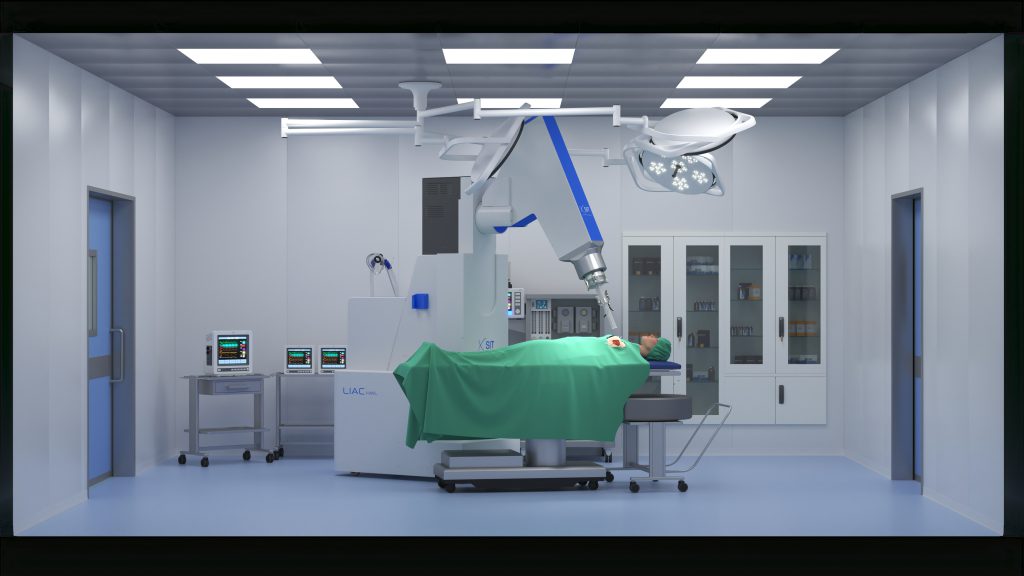Key concepts
“Intra-Operative Radiation Therapy (IORT) in its broadest sense refers to the delivery of irradiation at the time of an operation."
“IORT evolved as an attempt to achieve higher effective doses of irradiation whilst dose-limiting structures are surgically displaced."
“IntraOperative irradiation (IORT) refers to delivery of a single dose of irradiation to a surgically exposed tumor or tumor bed whilst the normal tissues are protected from the irradiation either by retracting the mobilized tissue or by shielding the anatomically fixed tissues. IOERT has traditionally been performed by using an electron beam as the source of irradiation.”
[Intraoperative Irradiation. Techniques and Results, Calvo F.A., Gunderson L.L. et al., Current Clinical Oncology, Second Edition, 2011.]
Today IOeRT, Intraoperative Radiation Therapy with electrons, is the only IORT technique included in the most relevant international guidelines for 9 cancer indications.
Advantages of IOeRT technique for clinical practice:
Improvement of local control is a key condition for disease free and overall survival.
Reduction (in the case of boost) and elimination (in case of single dose) of the external radiotherapy cycle.
Time zero between surgery and the delivery of radiotherapy, neoplastic cells growth from microscopic residual disease follows an exponential course immediately after surgery. With IOeRT this problem is solved.
Precision, thanks to the direct visualization of the target.
Significant reduction of dose to healthy tissues. The direct access of irradiation to the target allows to displace and mechanically protect numerous dose-sensitive normal tissue uninvolved by cancer.
Minimization of side effects, less toxicity, complete skin sparing and better cosmetic outcome when compared to external beam radiation therapy.
Feasibility of the treatment as the only solution when external radiation therapy is critical or even not possible (treatments of recurrences, patients with a pacemaker or decreased mobility).
IOeRT boost is particularly efficacious for the treatment of locally advanced cancers. IOeRT boost combined with external RT and chemotherapy allows to achieve excellent results of local control and overall survival (2016-2017 NCCN guidelines).

Short history of IOeRT

The very beginning
The idea of irradiating the tumour bed immediately after tumour removal dates back to 1904 and happened for the first time in Barcelona (Spain). The concept was easy and effective: irradiating the target directly treating on an open wound trying to avoid the healthy tissues. Back then the only available technology was low energy kV irradiators and its deployment started in very few centers. Prof. Beck from the UK described the IOeRT procedure in 1909.
The heroic Era
We have to look to Japan in the late 1970’s to see data which can be compared to what is done in the modern clinical practice and observe what Prof. Abe did at Kyoto University. He started the extensive use of IOeRT using high energy electrons. Such charged particles ensured proper penetration and homogeneity, performances physically unachievable with low energy kV.
Prof. Abe’s goal was delivering a possibly curative dose without facing the toxicity complications as in External Beam Radiation Therapy (EBRT). In order to perform IOeRT treatment, it was necessary to transport the patient from OR to the LINAC’s bunker. The Radiation Oncologists refers to this era as the “heroic era of IOeRT” since the “open” patient was transported through aisles and elevators from the OR block to the LINAC bunker, representing a significant logistic and safety challenge. Despite the challenge and based on these important results, IOeRT started to be adopted in Europe and in the USA following Prof. Abe’s patient transportation method and delivering the treatment with adapted EBRT LINACs.
Some constrains…
The use of IOeRT was accelerated but a combination of factors which instead actually slowed its growth around the 1990’s. Transporting the patient was very complicated and risky, since requiring several human resources to guarantee its success. Only a few Universities/Academic Centers could count on such resources. Building an OR in the LINAC bunker was seen as a very expensive solution and in the meanwhile EBRT technology started offering new and more precise treatment solutions, challenging IOeRT especially concerning the issue of patient transportation. Furthermore no IOeRT dedicated technology was available in the OR.
The first step toward future
In 1997, the first IOERT dedicated solutions was conceived, the NOVAC7, manufactured by the company NRT. This technological platform represented a huge step forward for IOERT to resolve the issue of patient transportation. These acclelerators, deployed in several centers, finally demonstrated IOERT benefits.
By the end of the 2000’s the new player Sordina presented a new concept, a very compact and light accelerator, the LIAC. In 2012 Sordina purchase NRT resulting in the operation that is today known as S.I.T.- Sordina IORT Technologies S.p.A. whch is the only Italian IOeRT Linac manufacturer.
SIT technologies
SIT launched the first IOeRT accelerator capable of operating in any standard operating room, the LIAC HWL, which solved completely any radiation protection issues. LIAC HWL technology demonstrated its value and effectiveness even when installed in countries with a very strict approach to radiation protection like Belgium.
Today, SIT is able to simulate and determine, using input data, LIAC HWL radiation protection behavior according to a given architectural space. Such extraordinary and patented radiation protection performances combined with LIAC HWL compact design and light weight, ensure LIAC HWL fitting into any standard OR avoiding architectural modification. By using its remote control, LIAC HWL can be fully operated in the OR to perform IOeRT treatment and easily moved from one OR to another, or from one floor to another by using any stretcher elevator, ensuring its use during the same day in multiple operating theaters. LIAC HWL can be installed and ready for treatment within 5 days from its delivery. These unique technical features made IOeRT performed with LIAC HWL a user friendly, accessible, safe and reliable radiation therapy option for patients.
SIT solution for one of the most discussed topics in IOeRT: the Treatment Planning System
After developing and patenting LIAC HWL, SIT spent its best efforts to provide an answer to one of the most discussed topics in IOeRT, the Treatment Planning System. An IOeRT TPS requires planning the treatment during surgery using the target’s real time image. Planning an IOeRT treatment based on pre-operative images after tumour resection will be inaccurate and misleading as the anatomy changes completely after surgical procedure and the biggest issue in IOeRT planning is addressed. Now this system is able to acquire real time images through ultrasound or CT/CBCT systems during surgery and simulate the treatment before even touching an applicator. This pre-planning opportunity is crucial to optimize IOeRT treatment planning.
LIAC HWL and the dedicated IOeRT TPS are today serving many centers performing IOeRT treatments helping thousands of oncological patients.

